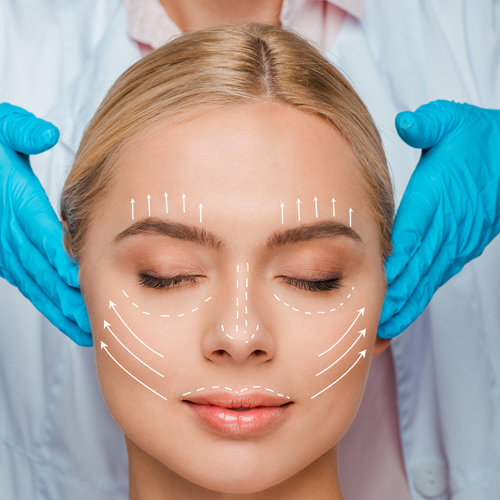Face lifts and neck lifts are popular cosmetic procedures designed to counteract the effects of aging and enhance the overall appearance of the face and neck. These surgeries can help address sagging skin, deep wrinkles, and other signs of aging, leading to a more youthful and refreshed look. In this guide, we’ll explore what each procedure involves, the different types available, and what to expect before, during, and after the surgery.
What is a Face Lift?
A face lift, or rhytidectomy, is a surgical procedure aimed at reducing visible signs of aging on the face. It primarily targets sagging skin, deep wrinkles, and loss of facial volume. The procedure involves tightening the underlying muscles and repositioning the skin to create a smoother and more youthful appearance.
Key Benefits of a Face Lift:
- Reduces Sagging: Tightens loose skin and underlying tissues, improving the contours of the face.
- Smooths Wrinkles: Minimizes deep wrinkles and folds, particularly around the mouth and nose.
- Enhances Facial Contours: Restores volume and definition to areas such as the cheeks and jawline.
What is a Neck Lift?
A neck lift, or lower rhytidectomy, is a procedure that focuses on the neck area, addressing concerns such as sagging skin, excess fat, and muscle laxity. It can be performed alone or in conjunction with a face lift to achieve comprehensive facial rejuvenation.
Key Benefits of a Neck Lift:
- Reduces Sagging: Tightens loose skin and removes excess fat, improving the contour of the neck.
- Improves Jawline Definition: Enhances the appearance of the jawline and eliminates a "turkey neck" or double chin.
- Smooths Skin: Addresses creases and bands in the neck area for a more youthful look.
Types of Face Lifts and Neck Lifts
There are several variations of face lifts and neck lifts, each designed to address specific concerns:
Face Lift Variations:
-
Traditional Face Lift
- Involves incisions made along the hairline and around the ears.
- Provides comprehensive rejuvenation by addressing sagging in the midface, lower face, and jawline.
- Ideal for individuals with significant aging signs.
-
Mini Face Lift
- Uses shorter incisions and targets less extensive areas of sagging.
- Suitable for patients with mild to moderate aging signs and offers a quicker recovery.
-
Mid-Face Lift
- Focuses on the central portion of the face, including the cheeks and lower eyelids.
- Ideal for addressing volume loss and sagging in the midface area.
Neck Lift Variations:
-
Traditional Neck Lift
- Involves incisions under the chin and around the ears.
- Addresses significant skin sagging, excess fat, and muscle laxity in the neck area.
-
Platysmaplasty
- Targets the platysma muscle in the neck, which can become lax with age.
- Often performed in conjunction with other neck lift techniques to improve overall results.
The Procedure
Both face lifts and neck lifts typically involve several key steps:
-
Consultation
During the consultation, you’ll discuss your goals with a board-certified plastic surgeon. The surgeon will evaluate your facial anatomy, review your medical history, and recommend a surgical plan based on your needs.
-
Pre-Surgery Preparation
You’ll receive instructions on how to prepare for the surgery, including dietary restrictions, medication guidelines, and possible lifestyle adjustments. A medical evaluation may be required to ensure you’re fit for the procedure.
-
Anesthesia
Face lifts and neck lifts are usually performed under general anesthesia, although local anesthesia with sedation may be used in some cases. Anesthesia ensures you are comfortable and pain-free during the procedure.
-
Incisions and Rejuvenation
The surgeon will make precise incisions based on the type of lift being performed. For a face lift, incisions are typically made along the hairline and around the ears. For a neck lift, incisions are often placed under the chin and around the ears. The underlying muscles and tissues are then tightened, and excess skin and fat are removed or repositioned to achieve the desired results.
-
Closing the Incisions
The incisions are closed with sutures, and a bandage or compression garment may be applied to support the healing process and reduce swelling.
Recovery and Aftercare
-
Initial Recovery
After the surgery, you will be monitored in a recovery area. Swelling, bruising, and discomfort are common and can be managed with prescribed medications and cold compresses. You may need to rest with your head elevated to minimize swelling.
-
Follow-Up Appointments
Regular follow-up appointments with your surgeon are essential to monitor healing and address any concerns. These visits help ensure that the incisions are healing properly and that you’re on track for a smooth recovery.
-
Long-Term Care
Avoid strenuous activities and heavy lifting for several weeks. Your surgeon will provide detailed instructions on when you can resume normal activities and exercise. Full recovery can take several weeks to months, with final results becoming more apparent as swelling subsides and the tissues settle.
Benefits of Face Lifts and Neck Lifts
- Youthful Appearance: Both procedures can significantly reduce signs of aging, resulting in a more youthful and rejuvenated appearance.
- Improved Contours: Enhances facial and neck contours, leading to a more defined jawline and smoother neck.
- Boosted Confidence: Many individuals experience a boost in self-esteem and satisfaction with their appearance.
Risks and Considerations
As with any surgery, face lifts and neck lifts carry certain risks, including:
- Infection
- Scarring
- Changes in Sensation
- Asymmetry or Dissatisfaction with Results
- Anesthesia Risks
Choosing a qualified and experienced surgeon is crucial to minimize these risks and achieve the best possible outcome.


